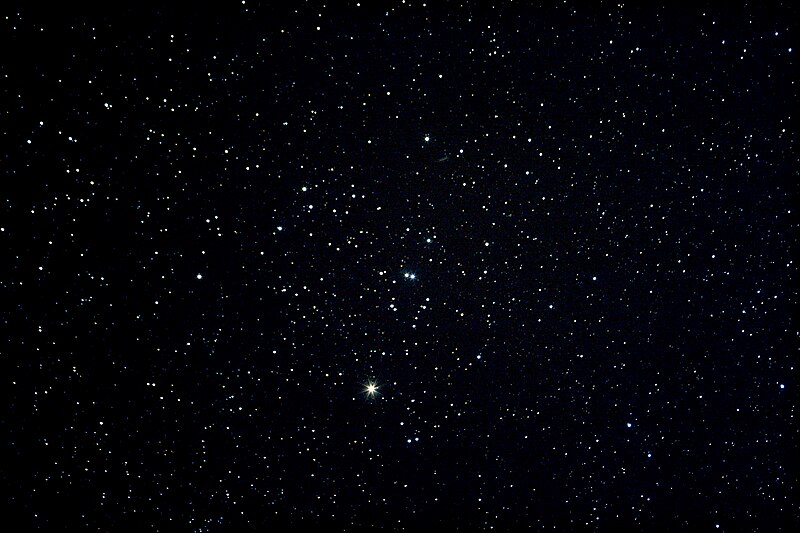Facts for Kids
The Hyades is a beautiful and important star cluster in the Taurus constellation, known for being the closest open cluster to Earth, helping us learn about stars and their formation.
Overview
Cultural References
Future Of The Hyades
Star Characteristics
Formation And History
Mythology And Folklore
Importance In Astronomy
Observation And Visibility
Scientific Research And Discoveries
Comparative Analysis With Other Clusters

Inside this Article
Greek Mythology
Ancient Greece
Temperature
Technology
Pleiades
Gravity
Taurus
Winter
Space
Time
Did you know?
🌌 The Hyades is the closest open star cluster to Earth, just 151 light-years away!
⭐ It contains around 200 stars that can be seen with the naked eye.
🌟 Aldebaran, a reddish giant star, is the brightest star in the Hyades cluster.
🤯 The Hyades began to form around 625 million years ago!
🔥 Most stars in the Hyades are about 150 million years old.
🔭 The Hyades helps astronomers study how stars are born and live.
🌍 The cluster has been recognized in many cultures throughout history.
🌙 The best time to see the Hyades is during the winter months in the Northern Hemisphere.
🔍 The Pleiades is another star cluster but is about 440 light-years away from Earth.
🌈 Over millions of years, the stars in the Hyades will slowly drift apart!
Introduction
It’s the closest open cluster to Earth, only about 151 light-years away. That means light from the Hyades takes 151 years to reach us! This cluster is made up of around 200 stars and is visible with the naked eye. The brightest star in the Hyades is Aldebaran, which is actually a reddish giant star and resembles the eye of the bull in the Taurus constellation. Can you spot the bull in the night sky? 🌟
Cultural References
In ancient Greece, the cluster was associated with the mythical Hyades sisters, who were said to be the daughters of Atlas. These sisters were believed to bring rain and nourishment to the crops. In some Native American cultures, the Hyades have special meanings in stories that connect people to the natural world. Even today, people use the Hyades in star charts and maps to find their way in the night sky! 🌠
Future Of The Hyades
Over many millions of years, the stars in the cluster will slowly drift apart due to gravity and movements in space. However, the Hyades will remain a key part of how we learn about the life cycles of stars. Some stars will continue to shine for billions of years while others may eventually turn into supernovae, exploding and creating new elements. The cluster, although breaking apart, will always be a favorite among astronomers and star lovers! ⭐😊
Star Characteristics
The stars are relatively young, with most being about 150 million years old. They are also similar in size, brightness, and temperature. The largest stars burn bright and fast, while smaller stars shine a bit dimmer and live longer. In the Hyades, some hot blue stars can be seen along with cooler yellow and red stars. Aldebaran, often mistaken for being part of the cluster, is actually a foreground star and is much closer to us!
Formation And History
Stars in the Hyades were born from giant clouds of gas and dust, similar to how our solar system formed. Over millions of years, gravity pulled these stars together to create the cluster we see today. Some stars from the Hyades have moved away, but it’s still considered a family of stars. Scientists love studying the Hyades because it helps us understand how stars are born and live their lives.
Mythology And Folklore
️ Many believed that their appearance in the sky marked the time for planting crops. In other cultures, the stars were seen as guides for navigation. The ancient Egyptians even called them the "Nurses of the Nile," as their rising coincided with the Nile flooding, which was crucial for agriculture. 🌾
Stories like these show how cultures have connected the stars with human lives!
Importance In Astronomy
By studying the cluster, scientists learn about star formation and evolution. Because all the stars formed around the same time, it’s like observing a big family of stars at different stages of life. The cluster’s stars also help astronomers measure distances in space accurately. The Hyades is a "benchmark" for other studies, helping us learn about even more distant star clusters and galaxies. It’s like a teacher showing us how to do our homework! 📚
Observation And Visibility
It is best seen in the evening sky during the winter months in the Northern Hemisphere. Look towards the constellation Taurus and you might see a “V” shape of stars representing the bull's head. The brightest star, Aldebaran, adds a beautiful color to the cluster. You can use binoculars or a small telescope to see even more stars in the Hyades. Just remember, the clearer the sky and the darker the place, the better your view! 🌌
Scientific Research And Discoveries
With telescopes and advanced technology, researchers have analyzed the cluster's age, composition, and motion. The famous astronomer, Galileo, even looked at the Hyades with his telescope in the early 1600s! Recently, studies have shown these stars contain elements like iron and calcium, which help astronomers understand the building blocks of our universe. By learning from the Hyades, we gain knowledge that helps us explore galaxies far beyond our own! 🌌✨
Comparative Analysis With Other Clusters
The Pleiades cluster, also known as the Seven Sisters, is another famous cluster, but it's farther away—around 440 light-years from Earth. The Hyades has about 200 stars, while the Pleiades has about 100. The Hyades is older than the Pleiades too! These differences help astronomers study how clusters develop over time. By observing different clusters, we unlock the mysteries of our universe! 🔍

